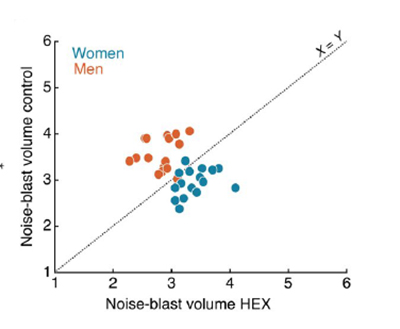Pheromones are air-borne signals transmitted between members of the same species. (Spoiler alert there is no evidence for an aphrodisiac pheromone to influence men or women.) That said, there are studies suggesting that humans, like other mammals, respond to those volatile chemicals we release into our personal atmosphere. The researchers were interested in whether a specific social signal in mice may have a role in humans.
The chemical is hexadecanal (HEX); I will leave a chemical discussion to my colleague, Dr. Bloom. Studies have shown HEX does act as a “social-buffering agent” (like one drink at a cocktail party) in mice, and it has been shown to reduce the “startle” response in humans. [1] HEX is emitted from our feces, skin, and breath, and HEX receptors are seen across the mammalian species, so it is certainly possible that it could be a human social signal.
The researchers carried out a series of experiments involving 127 participants, 52% men, mean age 25 or so—the experiment involving two phases. First, a provocation phase in which a computer game was played with a purported human opponent (really an algorithm) designed to provoke an aggressive response in the subject because of the discriminatory behavior of the algorithm in the division of money. In the study phase of the experiment, the subjects again played against the algorithm disguised as a human. In this game, the goal was to be the first to identify a change in the shape of a target. Those noting the change first could blast their opponent with a loud noise, the measure of aggression. Of course, the algorithm here was rigged and won only a third of the time and emitted random blasts at the human subject.
 The control group was surrounded by the odor of eugenol, a component of the essential oils that fragrance clove, nutmeg, or cinnamon. The experimental group had the eugenol mixed with HEX. The participants were not able to note anything other than the odor of the eugenol. Throughout several experiments, the researchers found that Hex “significantly lowered aggression” in men and “significantly increased aggression” in women.
The control group was surrounded by the odor of eugenol, a component of the essential oils that fragrance clove, nutmeg, or cinnamon. The experimental group had the eugenol mixed with HEX. The participants were not able to note anything other than the odor of the eugenol. Throughout several experiments, the researchers found that Hex “significantly lowered aggression” in men and “significantly increased aggression” in women.
This phenomenon was determined by MRI studies and the authors concluded that the HEX receptors ultimately impact the right temporal pole, left amygdala, and both orbitofrontal cortices. We can put this information aside because associating neuroanatomy with behavior is not well-established science. Suffice it to say, these areas have been associated with aggression and appear to have been “recruited” by HEX, a volatile released by our bodies.
“In other words, in humans, like in rodents, a “social odor” activates the “social brain.’”
Why would this be?
Ordinarily, stress and stress-volatiles promote aggression in men and less aggression in women. The researchers point out that as stress resolves, men become less aggressive, women more so. The point is that the same stimuli may have very different responses based on gender. So, it is not overly surprising the HEX produces a “dimorphic” response. Of course, it begs the question of why. As they ask, “what behavioral setting could underlie selection for a body volatile that increases aggression in women but decreases it in men? Or in other words, what could be the ecological relevance of these results?”
That brings us back to that special smell of a baby’s head. Sniffing a baby’s head provides an olfactory reward to the mother and perhaps the father. More importantly, the bonding of sniffing their head brings out the “Mama bear” in the mothers. It may simultaneously reduce those aggressive tendencies in “Papa bear” that provides an equally protective role towards the infant. Interestingly, HEX could be a mechanism that increases the likelihood of an infant’s survival.
As it turns out, the researchers uncovered a prior study that examined some of the volatiles of baby-heads. To their dismay, HEX was not studied. But they contacted the other researchers who studied an additional 19 babies searching for HEX using gas chromatography. HEX was found in 17 of the 19 and was “one of the most abundant baby-head volatiles.” Babies emit HEX, and these experiments suggest that it serves an evolutionary role in protecting their lives by calming Pops and bringing out a very protective mom.
[1] “The startle response is an unconscious defensive response, i.e., protecting your head or eyes from a sudden noise or movement.
Source: Sniffing the human body volatile hexadecanal blocks aggression in men but triggers aggression in women Science Advances




